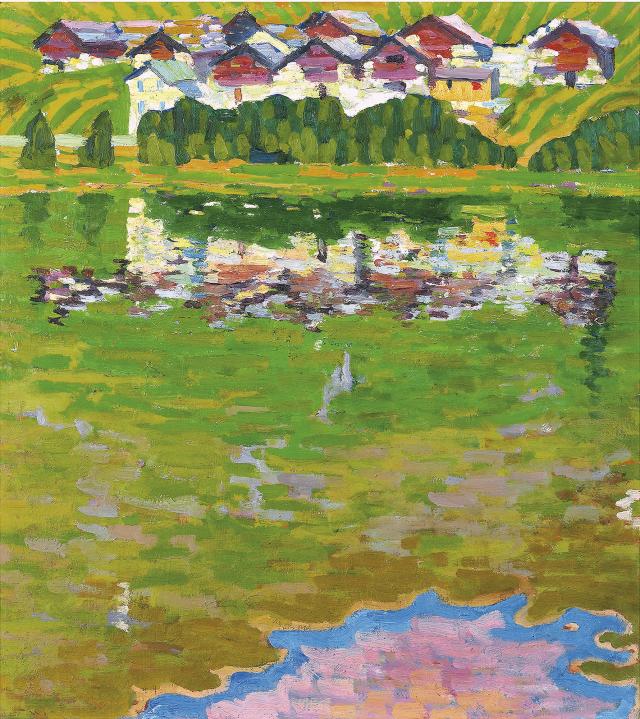Giovanni Giacometti deliberately chose to remain outside the major art centres, preferring the proximity of Engadine landscapes and the luminous atmosphere of Val Bregaglia. In his studios in Stampa and Maloja – a pasture perched high in the Alps where he began spending his summers in 1901 – Giacometti elaborated his pictures in direct day-to-day contact with the mountains. The formal elements and colours of this environment proved an inexhaustible source of inspiration and the driving force behind an artistic output that the artist himself constantly called into question.
When Annetta, his wife, inherits a house in Capolago, this village near Maloja quickly becomes one of the subjects of Giacometti’s painting. In Capolago, sole (Capolago, Sun), a smooth stretch of lake that is inundated with light and glowing with bright hues boasts a frieze of violet and mauve houses that are mirrored in the greenish yellow waters of Lake Sils. Juxtaposing the various surfaces with their fine hatching, the artist composes a view devoid of perspective in which the motif becomes an excuse for a play of chromatic contrasts and bright effects of light. Abandoning illusionism and the anecdotal, Giacometti focuses on the shimmering points on the water that reflect the intense daylight, modelling the expanse of lake with contrasting highlights.
For Giacometti, the first decade of the 20th century was a time of many stylistic and technical experiments. By 1906 he had achieved a personal interpretation of the new French trends. His pictorial language is now a synthesising one whilst his palette will become ever more daring and expressive. He abandons the thin filamentous brushwork of his mentor, Giovanni Segantini; from now on the hatching-like strokes of his brush will be subjected to other influences. Playing on linear oppositions, for instance, he combines the sinuous, decorative line of Jugendstil – seen in the dazzling blue that outlines one reflection playing on the lake surface – with the construction of a rigorous image in a style that is stamped by the influence of Vincent Van Gogh, whom he has recently discovered and studied. His long broad dappled streaks directly recall the tiny rod-shaped brushstrokes employed by the Dutch painter, which Giacometti combines with the chromatic atmosphere of Graubünden’s lakes.
When Annetta, his wife, inherits a house in Capolago, this village near Maloja quickly becomes one of the subjects of Giacometti’s painting. In Capolago, sole (Capolago, Sun), a smooth stretch of lake that is inundated with light and glowing with bright hues boasts a frieze of violet and mauve houses that are mirrored in the greenish yellow waters of Lake Sils. Juxtaposing the various surfaces with their fine hatching, the artist composes a view devoid of perspective in which the motif becomes an excuse for a play of chromatic contrasts and bright effects of light. Abandoning illusionism and the anecdotal, Giacometti focuses on the shimmering points on the water that reflect the intense daylight, modelling the expanse of lake with contrasting highlights.
For Giacometti, the first decade of the 20th century was a time of many stylistic and technical experiments. By 1906 he had achieved a personal interpretation of the new French trends. His pictorial language is now a synthesising one whilst his palette will become ever more daring and expressive. He abandons the thin filamentous brushwork of his mentor, Giovanni Segantini; from now on the hatching-like strokes of his brush will be subjected to other influences. Playing on linear oppositions, for instance, he combines the sinuous, decorative line of Jugendstil – seen in the dazzling blue that outlines one reflection playing on the lake surface – with the construction of a rigorous image in a style that is stamped by the influence of Vincent Van Gogh, whom he has recently discovered and studied. His long broad dappled streaks directly recall the tiny rod-shaped brushstrokes employed by the Dutch painter, which Giacometti combines with the chromatic atmosphere of Graubünden’s lakes.
